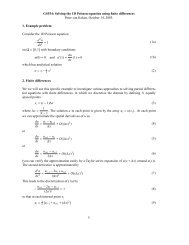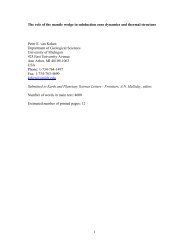Quantitative paleoenvironmental and paleoclimatic reconstruction ...
Quantitative paleoenvironmental and paleoclimatic reconstruction ...
Quantitative paleoenvironmental and paleoclimatic reconstruction ...
You also want an ePaper? Increase the reach of your titles
YUMPU automatically turns print PDFs into web optimized ePapers that Google loves.
ARTICLE IN PRESS<br />
20 N.D. Sheldon, N.J. Tabor / Earth-Science Reviews xxx (2009) xxx–xxx<br />
equivocal at this point. Thermodynamic models in general oversimplify<br />
the problem of estimating Precambrian pCO 2 levels, <strong>and</strong> by<br />
slightly changing starting assumptions (e.g., SIS paleobarometers of<br />
Rye et al., 1995; Ohmoto et al., 2004; Sheldon, 2006b) or thermodynamic<br />
data (e.g., Sheldon, 2006b) vastly different conclusions may<br />
be drawn. Extreme caution is thus advocated in their application,<br />
because the mostly widely cited one (Rye et al., 1995) has a number of<br />
fundamental flaws, <strong>and</strong> other approaches (Hessler et al., 2004) may<br />
have only limited application to relatively rare sedimentary occurrences.<br />
Instead, as discussed in Section 5.3.2, a mass-balance model for<br />
reconstructing Precambrian pCO 2 levels is favored because it gives<br />
reproducible results consistent with geologic evidence, is independent<br />
of assumptions about pO 2 values, <strong>and</strong> takes into account both<br />
pedogenic <strong>and</strong> diagenetic processes (Sheldon, 2006b).<br />
6.2.2. Earliest Triassic soil formation<br />
One of the primary weaknesses of the single-equation approach to<br />
Precambrian conditions is the amount of uncertainty about the<br />
original pedogenic mineral assemblage. Given that model interpretations<br />
were based on the presence/absence of a single mineral at a<br />
single site, it is unsurprising that inconsistent results were obtained.<br />
Those uncertainties decrease with younger rocks, with settings that<br />
are better understood, <strong>and</strong> with model approaches that rely on the<br />
mineral assemblage that is actually present rather than on some<br />
theoretical assemblage. The key with any model is the ability to<br />
evaluate it successfully against “real” data. Thus, a single-equation<br />
approach applied to a well-characterized geologic setting has a greater<br />
chance of success. Sheldon <strong>and</strong> Retallack (2002, 2003) have used a<br />
single-equation equilibrium model to examine pedogenic processes in<br />
well-studied (Retallack <strong>and</strong> Krull, 1999; Krull <strong>and</strong> Retallack, 2000;<br />
Retallack et al., 2005; Sheldon, 2006a) earliest Triassic paleosols in<br />
Antarctica. Krull <strong>and</strong> Retallack (2000; see also Sarkar et al., 2003)<br />
presented organic matter δ 13 C data that was interpreted to represent a<br />
significant methane release event coincident with the Permian–<br />
Triassic extinction, possibly due to destabilization of seafloor clathrates<br />
or to diking of permafrost fields (Retallack <strong>and</strong> Jahren, 2008).<br />
C cycle modeling by Berner (2002) suggests that large isotopic<br />
excursions can only be caused by introduction of methane (i.e.,<br />
Siberian Traps volcanism was ruled out). Because methane oxidizes on<br />
very short time scales (7–24 years in the present atmosphere), local<br />
reduction may occur in relatively confined settings such as soils. The<br />
earliest Triassic of Antarctica was characterized by waterlogged soils<br />
(Sheldon, 2006a) that were essentially coal swamp environments<br />
without peat accumulation (Retallack et al., 1996) that could be<br />
termed “clastic swamps.” The unusual serpentine group mineral<br />
berthierine was also present (Sheldon <strong>and</strong> Retallack, 2002, 2003), a<br />
strong indicator of chemically reducing conditions (see references in<br />
Sheldon <strong>and</strong> Retallack, 2002). Thus, Sheldon <strong>and</strong> Retallack (2002,<br />
2003) used an equilibrium model based on the following equation to<br />
examine if the presence of berthierine gives a useful constraint on<br />
<strong>paleoenvironmental</strong> conditions at the time of its formation:<br />
Al 2 S 2 i 2 O 5 ðOHÞ 4ðKaolÞ<br />
+Fe 2 O 3ðHemÞ<br />
+ 1 4 CH 4 =Fe 2 Al 2 SiO 5 ðOHÞ 4ðbertÞ<br />
+ SiO 2aq ð Þ + 1 2 H 2O ðaqÞ<br />
+ 1 4 CO 2aq ð Þ ð35Þ<br />
Assuming pure minerals <strong>and</strong> a dilute solution (i.e., aH 2 O≈1), the<br />
following equilibrium relationship was developed (using data from the<br />
SOLTHERM database; see Pal<strong>and</strong>ri <strong>and</strong> Reed, 2001) that allowed them to<br />
model the conditions that would result from elevated methane levels:<br />
a SiO2ðaqÞ<br />
p 1 4 CO2<br />
p 1 4 CH4<br />
= K =10 − 1:673 ð25 ○ CÞ ð36Þ<br />
Over a realistic temperature range (10–25 °C), a variety of methane<br />
scenarios (2–100× present levels) were examined (see Fig. 1 of Sheldon<br />
<strong>and</strong> Retallack, 2003). At aSiO 2(aq) values comparable to modern surface<br />
waters (10 −4.047 ), very high soil gas pCO 2 values (N1000 PAL; modern<br />
tropical soils often exceed 100 PAL, Brook et al.,1983) are indicated for all<br />
of the methane scenarios. This result provides an explanation for the<br />
“post-apocalyptic greenhouse” paleosols observed in Antarctica (Retallack<br />
<strong>and</strong> Krull, 1999), which included paleo-Ultisols forming at N65°S<br />
even though modern Ultisols are limited to ±45° N or S today by giving<br />
evidence for short-term exceptionally high soil gas pCO 2 levels (Sheldon<br />
<strong>and</strong> Retallack, 2002, 2003; Sheldon, 2006a). Evidence for these shortterm<br />
chemically reducing but highly acidic soil gas conditions at high<br />
paleo-latitudes is now widespread for the earliest Triassic, with nine<br />
berthierine-bearing localities in Antarctica <strong>and</strong> Australia, including all of<br />
the paleosol-bearing Antarctic sequences that have been widely studied<br />
(Sheldon, 2006a).<br />
This type of application of thermodynamic modeling (i.e., in<br />
concert with whole rock geochemical <strong>and</strong> isotopic data), where there<br />
is geological evidence to “aim at”, is much more effective than the<br />
more theoretical approaches that have been applied to Precambrian<br />
paleosols. Thermodynamic modeling of soil <strong>and</strong> paleosol formation<br />
does represent a potentially powerful tool, but less so when used<br />
exclusively <strong>and</strong> in scenarios where there is relatively little additional<br />
proxy data to work with. For Phanerozoic paleosols, this is less likely<br />
to be a problem than for Precambrian ones, <strong>and</strong> in places where the<br />
diagenetic setting is well understood, single-equation thermodynamic<br />
modeling is likely to give additional insight into unusual mineral<br />
assemblages observed in paleosols, but probably should not be used as<br />
a “st<strong>and</strong>alone” proxy any more than for the Precambrian.<br />
6.3. Multiple-equation approaches<br />
Soils are potentially excellent proxy records of environmental<br />
conditions because they form in direct contact with the atmosphere.<br />
As a result, gas contents in soils equilibrate with atmospheric gases.<br />
However, due to soil respiration, soil pCO 2 may be up to 100–200<br />
times higher than that of the atmosphere (Brook et al., 1983; Volk,<br />
1987) in tropical settings, with generally lower concentrations in<br />
temperate settings. The minimum soil pCO 2 level expected is that of<br />
atmospheric pCO 2 , which corresponds to no biological productivity.<br />
Elevated soil pCO 2 values are associated with high-biomass systems or<br />
with waterlogged settings where diffusive loss of soil pCO 2 to the<br />
atmosphere (if soil pCO 2 Natmospheric pCO 2 ) is inhibited. Thus, welldrained<br />
soils with low to moderate productivity will generally have<br />
low soil pCO 2 , but still somewhat greater than atmospheric pCO 2 .<br />
Because atmospheric pCO 2 level cannot be lower than the soil<br />
pCO 2 levels under open-system exchange, equilibrium modelling of<br />
abiotic weathering reactions can constrain minimum atmospheric<br />
pCO 2 levels (Sheldon, 2006d) if the weathering environment is wellunderstood.<br />
To illustrate this, we will summarize Sheldon's (2006d)<br />
efforts to model the formation of intra-basaltic paleosols preserved<br />
between middle Miocene Columbia River Flood Basalt Province flows.<br />
In other words, if present levels of pCO 2 are sufficient to create the<br />
observed degree of weathering in these paleosols, then it is likely that<br />
paleo-atmospheric pCO 2 levels were also at near-modern levels<br />
because biota can only serve to enhance the degree of weathering.<br />
This approach is somewhat indirect, but the thermodynamics of<br />
microbial <strong>and</strong> plant interactions during weathering are still poorly<br />
understood.<br />
The computer program CHILLER (e.g., Pal<strong>and</strong>ri <strong>and</strong> Reed, 2001)<br />
allows users to calculate heterogeneous equilibrium of gas–mineral–<br />
water systems. CHILLER forces equilibrium with different water <strong>and</strong><br />
gas mixtures by treating gases as homogeneous minerals. Each of the<br />
different gas compositions is thus a separate “mineral”, with separate<br />
thermodynamic behaviour. In other words, a water-rock system in<br />
equilibrium with present atmospheric conditions is in equilibrium<br />
with the “minerals” called “fCO 2 –3.5” (CO 2 fugacity=10 − 3.5 ) <strong>and</strong><br />
“fO 2 –0.7” (O 2 fugacity=10 − 0.7 ). To look at a range of possible pCO 2<br />
Please cite this article as: Sheldon, N.D., Tabor, N.J., <strong>Quantitative</strong> <strong>paleoenvironmental</strong> <strong>and</strong> <strong>paleoclimatic</strong> <strong>reconstruction</strong> using paleosols, Earth-<br />
Science Reviews (2009), doi:10.1016/j.earscirev.2009.03.004















